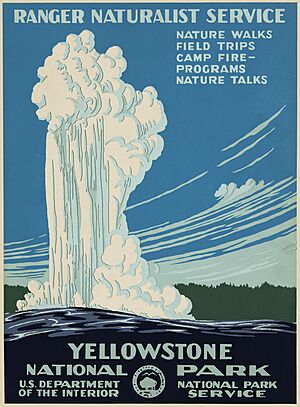List of national parks of the United States facts for kids
The United States has 63 amazing national parks! These special places are protected by the government and managed by the National Park Service. They are chosen for their incredible natural beauty, unique landforms, different kinds of plants and animals, and fun activities you can do there. Think of them as giant outdoor classrooms and playgrounds!
National parks are usually very large. Unlike some other protected areas, you can't hunt or take things like minerals from them. Some national parks are even connected to "national preserves," which have slightly different rules but are managed together.
The very first national park was Yellowstone National Park, created in 1872. Later, in 1916, the National Park Service was formed. Its job is to "save the beautiful scenery, historical items, and wildlife, and to let people enjoy them in a way that keeps them safe for future generations." This means they want to make sure these parks stay wonderful for you and your kids!
Many national parks were first protected as "national monuments" by the President before Congress officially made them national parks. The newest national park is New River Gorge National Park and Preserve. Some parks are so special that they are also recognized by UNESCO as World Heritage Sites or Biosphere Reserves.
National parks are found in 30 states and two U.S. territories: American Samoa and the U.S. Virgin Islands. California has the most parks with nine, and Alaska is next with eight. The biggest park is Wrangell–St. Elias National Park and Preserve in Alaska. It's huge, bigger than nine of the smallest states combined! The smallest park is Gateway Arch National Park in Missouri.
In 2021, a record number of people visited national parks, with over 92 million visitors! Great Smoky Mountains National Park is the most popular, with almost 13 million visitors in 2022. On the other hand, very few people visit remote parks like Gates of the Arctic National Park and Preserve in Alaska.
Exploring U.S. National Parks
- Legend
- Green – UNESCO World Heritage Sites
- Blue – UNESCO Biosphere Reserves
- Purple – Parks in both UNESCO programs
| Name | Image | Location | Established | Size (acres) | Visitors (2022) | What makes it special? |
|---|---|---|---|---|---|---|
| Acadia | 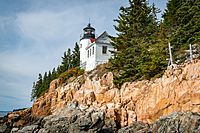 |
Maine | February 26, 1919 | 49,071 | 3,970,260 | This park covers most of Mount Desert Island and other coastal islands. It has the tallest mountain on the Atlantic coast, granite peaks, ocean beaches, forests, and lakes. You can find freshwater, estuary, forest, and ocean habitats here. |
| American Samoa |  |
American Samoa | October 31, 1988 | 8,257 | 12,135 | This is the southernmost national park, located on three Samoan islands in the South Pacific. It protects beautiful coral reefs, rainforests, volcanic mountains, and white beaches. It's home to unique animals like flying foxes, sea turtles, and many fish species. |
| Arches | 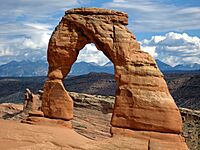 |
Utah | November 12, 1971 | 76,679 | 1,460,652 | This park has over 2,000 amazing natural sandstone arches, like the famous Delicate Arch. Millions of years of wind and water have shaped these structures in a desert. You can also see stone pinnacles and balancing rocks. |
| Badlands |  |
South Dakota | November 10, 1978 | 242,756 | 1,006,809 | The Badlands are a collection of unique buttes, spires, and grasslands in South Dakota. They hold the largest collection of ancient mammal fossils from the Eocene and Oligocene periods. You might see bison, bighorn sheep, and prairie dogs here. |
| Big Bend |  |
Texas | June 12, 1944 | 801,163 | 514,107 | Named for the big bend in the Rio Grande river, this park is a large part of the Chihuahuan Desert. It's great for exploring the Chisos Mountains and canyons along the river. It also has many ancient fossils and Native American artifacts. (This is a Biosphere Reserve.) |
| Biscayne | 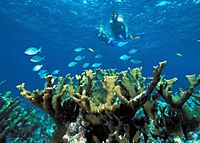 |
Florida | June 28, 1980 | 172,971 | 701,023 | This park is mostly underwater, at the northern end of the Florida Keys. It has four connected marine environments: mangrove forests, the Bay, the Keys, and coral reefs. You might spot West Indian manatees, American crocodiles, and sea turtles. |
| Black Canyon of the Gunnison | 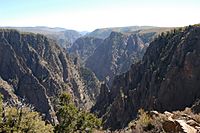 |
Colorado | October 21, 1999 | 30,780 | 297,257 | This park protects a section of the Gunnison River, which has carved incredibly steep canyon walls from very old rock. It's known for some of the steepest cliffs and oldest rock in North America, and it's popular for river rafting and rock climbing. |
| Bryce Canyon | 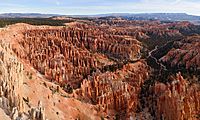 |
Utah | February 25, 1928 | 35,835 | 2,354,660 | Bryce Canyon is a natural amphitheater with hundreds of tall, colorful sandstone hoodoos. These unique rock formations were shaped by erosion. Native Americans and later Mormon pioneers lived in this area. |
| Canyonlands |  |
Utah | September 12, 1964 | 337,598 | 779,147 | This landscape was carved into a maze of canyons, buttes, and mesas by the Colorado River and Green River. The park has thousands of rock pinnacles and arches, plus ancient artifacts from the Ancient Pueblo peoples. |
| Capitol Reef | 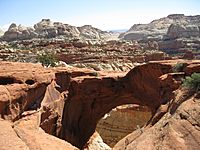 |
Utah | December 18, 1971 | 241,905 | 1,227,608 | The park's Waterpocket Fold is a 100-mile-long wrinkle in the Earth's crust, showing off many different rock layers. You can also see monoliths, eroded buttes, and sandstone domes, including one that looks like the U.S. Capitol building. |
| Carlsbad Caverns | 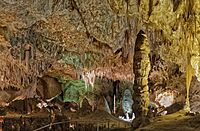 |
New Mexico | May 14, 1930 | 46,766 | 390,932 | Carlsbad Caverns has 117 caves, with the longest one stretching over 120 miles! The "Big Room" is almost 4,000 feet long. The caves are home to over 400,000 Mexican free-tailed bats. Above ground, you'll find the Chihuahuan Desert. (This is a World Heritage Site.) |
| Channel Islands | 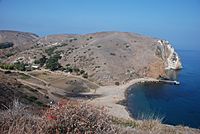 |
California | March 5, 1980 | 249,561 | 323,245 | Five of the eight Channel Islands are protected here, with half of the park underwater. The islands have a special Mediterranean climate and were originally settled by the Chumash people. They are home to over 2,000 plant and animal species, including the unique island fox. (This is a Biosphere Reserve.) |
| Congaree |  |
South Carolina | November 10, 2003 | 26,693 | 204,522 | Located on the Congaree River, this park has the largest remaining old-growth floodplain forest in North America. Some of its trees are the tallest in the eastern U.S. An elevated walkway, the Boardwalk Loop, lets visitors explore the swamp. (This is a Biosphere Reserve.) |
| Crater Lake |  |
Oregon | May 22, 1902 | 183,224 | 527,259 | Crater Lake sits in the giant bowl of an ancient volcano called Mount Mazama, which collapsed 7,700 years ago. It's the deepest lake in the U.S. and is famous for its bright blue color and clear water. Wizard Island is a smaller volcanic island within the lake. |
| Cuyahoga Valley | 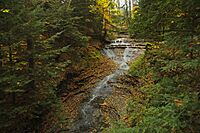 |
Ohio | October 11, 2000 | 32,572 | 2,913,312 | This park along the Cuyahoga River features waterfalls, hills, and trails. You can learn about early rural life and follow the historic Ohio and Erie Canal Towpath Trail. The park also has many old homes, bridges, and offers scenic train rides. |
| Death Valley | 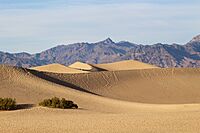 |
California, Nevada | October 31, 1994 | 3,408,396 | 1,128,862 | Death Valley is the hottest, lowest, and driest place in the United States. Temperatures can go above 130°F (54°C)! It protects Badwater Basin, the lowest point in North America at 282 feet below sea level. You'll find canyons, sand dunes, mountains, and over 1,000 plant species here. (This is a Biosphere Reserve.) |
| Denali |  |
Alaska | February 26, 1917 | 4,740,911 | 427,562 | This park is centered around Denali, the tallest mountain in North America. A single road leads to Wonder Lake, and most of the park can only be explored by special tour buses. You'll see long glaciers, boreal forests, and wildlife like grizzly bears, moose, and caribou. (This is a Biosphere Reserve.) |
| Dry Tortugas |  |
Florida | October 26, 1992 | 64,701 | 78,488 | The islands of the Dry Tortugas are at the very end of the Florida Keys. Here you'll find Fort Jefferson, a huge Civil War-era fort. The park also protects untouched coral reefs and shipwrecks. You can only reach it by plane or boat. (This is a Biosphere Reserve.) |
| Everglades | 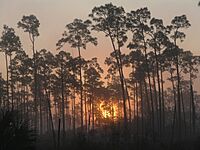 |
Florida | May 30, 1934 | 1,508,939 | 1,155,193 | The Everglades is the largest tropical wilderness in the United States. This amazing ecosystem of mangroves and rainforests is home to 36 protected species, including the Florida panther, American crocodile, and West Indian manatee. (This is a World Heritage Site and a Biosphere Reserve.) |
| Gates of the Arctic | 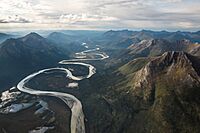 |
Alaska | December 2, 1980 | 7,523,897 | 9,457 | This is the northernmost park in the country, protecting a vast area of pure wilderness in Alaska's Brooks Range. There are no park facilities here. Alaska Natives have lived off this land and relied on caribou for 11,000 years. |
| Gateway Arch |  |
Missouri | February 22, 2018 | 193 | 1,618,774 | The Gateway Arch is a 630-foot-tall arch built in the 1960s. It honors the Lewis and Clark Expedition and the country's move westward. An underground museum tells the story of the arch's construction and westward expansion. |
| Glacier |  |
Montana | May 11, 1910 | 1,013,126 | 2,908,458 | This park is the U.S. part of the Waterton-Glacier International Peace Park. It has 26 glaciers that are quickly shrinking, and 130 lakes surrounded by Rocky Mountain peaks. The famous Going-to-the-Sun Road offers amazing views. (This is a World Heritage Site and a Biosphere Reserve.) |
| Glacier Bay | 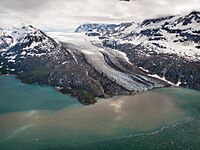 |
Alaska | December 2, 1980 | 3,223,383 | 545,758 | Glacier Bay has tidewater glaciers (glaciers that meet the ocean), mountains, fjords, and a temperate rainforest. It's home to many grizzly bears, mountain goats, whales, seals, and eagles. Since 1794, the glaciers here have melted back over 65 miles! (This is a World Heritage Site and a Biosphere Reserve.) |
| Grand Canyon |  |
Arizona | February 26, 1919 | 1,201,647 | 4,732,101 | The Grand Canyon, carved by the mighty Colorado River, is 277 miles long, up to 1 mile deep, and up to 15 miles wide. Millions of years of erosion have created this massive canyon, showing off colorful rock layers. (This is a World Heritage Site.) |
| Grand Teton |  |
Wyoming | February 26, 1929 | 310,044 | 2,806,223 | Grand Teton is the tallest mountain in the beautiful Teton Range. The park's historic Jackson Hole valley and clear lakes are full of unique wildlife, all set against a backdrop of jagged mountains. (This is a Biosphere Reserve.) |
| Great Basin | 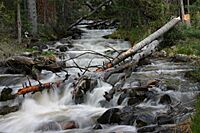 |
Nevada | October 27, 1986 | 77,180 | 142,115 | This park is centered around Wheeler Peak, Nevada's second tallest mountain. It protects 5,000-year-old bristlecone pine trees, a rock glacier, and the limestone Lehman Caves. Because it's so remote, it has some of the darkest night skies in the country. |
| Great Sand Dunes | 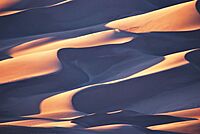 |
Colorado | September 24, 2004 | 107,346 | 493,428 | These are the tallest sand dunes in North America, reaching up to 750 feet high! They were formed by deposits from the ancient Rio Grande river. The park also has alpine lakes, tall mountains, and old-growth forests. |
| Great Smoky Mountains |  |
North Carolina, Tennessee | June 15, 1934 | 522,427 | 12,937,633 | The Great Smoky Mountains, part of the Appalachian Mountains, have many different elevations. This means they are home to over 400 animal species, 100 tree species, and 5,000 plant species. Hiking is very popular here, with over 800 miles of trails. (This is a World Heritage Site and a Biosphere Reserve.) |
| Guadalupe Mountains | 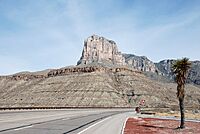 |
Texas | September 30, 1972 | 86,367 | 219,987 | This park contains Guadalupe Peak, the highest point in Texas. It also has the beautiful McKittrick Canyon with its bigtooth maples, a part of the dry Chihuahuan Desert, and a fossilized coral reef from the Permian era. |
| Haleakalā | 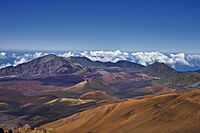 |
Hawaii | July 1, 1961 | 33,489 | 1,087,616 | The Haleakalā volcano on Maui has a very large crater with many cinder cones. The park protects the most endangered species of any U.S. national park, including the unique Hawaiian goose. (This is a Biosphere Reserve.) |
| Hawaiʻi Volcanoes | 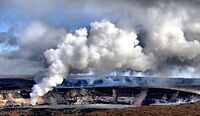 |
Hawaii | August 1, 1916 | 344,812 | 1,580,961 | This park on the Big Island protects the Kīlauea and Mauna Loa volcanoes, two of the world's most active volcanoes. It has diverse ecosystems, from tropical forests at sea level to barren lava fields at over 13,000 feet. (This is a World Heritage Site and a Biosphere Reserve.) |
| Hot Springs | 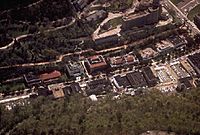 |
Arkansas | March 4, 1921 | 5,554 | 2,646,133 | Hot Springs was first protected in 1832, making it the oldest area managed by the National Park Service. Natural hot springs flow from the Ouachita Mountains, offering a relaxing experience in a historic setting. Bathhouse Row shows off beautiful 19th-century buildings. |
| Indiana Dunes | 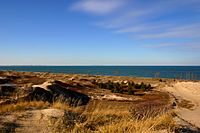 |
Indiana | February 15, 2019 | 15,349 | 2,834,180 | This park is a 20-mile stretch of sandy beaches and tall dunes along the southern shore of Lake Michigan. It also includes grassy prairies, peat bogs, and wetlands, home to over 2,000 species of plants and animals. |
| Isle Royale | 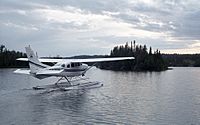 |
Michigan | April 3, 1940 | 571,790 | 25,454 | This is the largest island in Lake Superior, a wild and isolated place. It has many shipwrecks, waterways, and hiking trails. The park also includes over 400 smaller islands. It's famous for the unique relationship between its wolf and moose populations. (This is a Biosphere Reserve.) |
| Joshua Tree | 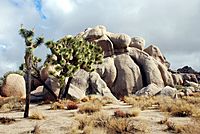 |
California | October 31, 1994 | 795,156 | 3,058,294 | This park covers large areas of the Colorado Desert and Mojave Desert, filled with vast stands of Joshua trees. You'll see different environments like sand dunes, dry lakes, rugged mountains, and huge rock formations. (This is a Biosphere Reserve.) |
| Katmai | 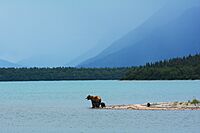 |
Alaska | December 2, 1980 | 3,674,529 | 33,908 | This park on the Alaska Peninsula protects the Valley of Ten Thousand Smokes, an ash flow from a 1912 volcano eruption. Over 2,000 grizzly bears come here every year to catch salmon. You might also see caribou, wolves, and moose. |
| Kenai Fjords | 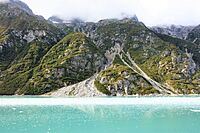 |
Alaska | December 2, 1980 | 669,650 | 389,943 | Near Seward, this park protects the Harding Icefield and at least 38 glaciers and fjords that flow from it. The only part you can reach by road is the shrinking Exit Glacier. Boat tours offer views of glaciers, whales, sea lions, and marine birds. |
| Kings Canyon | 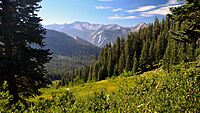 |
California | March 4, 1940 | 461,901 | 640,986 | This park is home to several giant sequoia groves, including the General Grant Tree, the world's second largest tree. It also features parts of the Kings River, which carved the dramatic granite canyon. (This is a Biosphere Reserve.) |
| Kobuk Valley |  |
Alaska | December 2, 1980 | 1,750,716 | 16,925 | Kobuk Valley protects 61 miles of the Kobuk River and three areas of sand dunes. These dunes, created by glaciers, can be 100 feet high and are the largest in the Arctic. Half a million caribou migrate through the dunes twice a year. |
| Lake Clark | 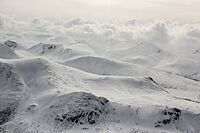 |
Alaska | December 2, 1980 | 2,619,816 | 18,187 | The area around Lake Clark has four active volcanoes, including Mount Redoubt, along with many rivers, glaciers, and waterfalls. You'll find temperate rainforests, a tundra plateau, and three mountain ranges here. |
| Lassen Volcanic |  |
California | August 9, 1916 | 106,589 | 446,291 | Lassen Peak is the largest lava dome volcano in the world. This park has all four types of volcanoes! Many hot spots, like fumaroles (steam vents), boiling pools, and bubbling mud pots, are heated by molten rock underground. |
| Mammoth Cave | 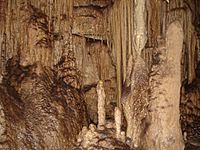 |
Kentucky | July 1, 1941 | 72,473 | 663,147 | With over 400 miles of explored passages, Mammoth Cave is the world's longest known cave system. It's home to unique underground wildlife like eight bat species and cave salamanders. Above ground, you can enjoy the Green River and hiking trails. (This is a World Heritage Site and a Biosphere Reserve.) |
| Mesa Verde | 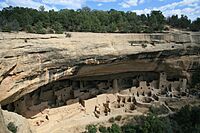 |
Colorado | June 29, 1906 | 52,485 | 499,790 | This park protects over 4,000 archaeological sites of the Ancestral Puebloan people. They lived here for at least 700 years. You can see amazing cliff dwellings built in the 12th and 13th centuries, like Cliff Palace with its 150 rooms. (This is a World Heritage Site.) |
| Mount Rainier | 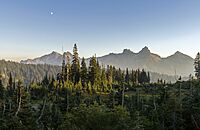 |
Washington | March 2, 1899 | 236,382 | 1,622,395 | Mount Rainier is an active volcano and the most prominent peak in the Cascades. It's covered by 26 glaciers, including the longest and largest in the U.S. The mountain is popular for climbing, and its meadows are full of wildflowers in season. |
| New River Gorge |  |
West Virginia | December 27, 2020 | 7,021 | 1,593,523 | The New River Gorge is the deepest river gorge east of the Mississippi River. The park covers the lower gorge area around the New River Gorge Bridge, which is great for whitewater rafting. You can also see the ghost town of Thurmond. |
| North Cascades |  |
Washington | October 2, 1968 | 504,781 | 30,154 | The mountains of the North Cascades Range have many glaciers and a complex geological history. Between the river valleys and high peaks, there are eight different life zones with 75 mammal and 1,600 plant species. It's popular for hiking and climbing. |
| Olympic | 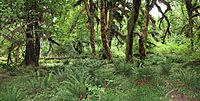 |
Washington | June 29, 1938 | 922,649 | 2,432,972 | This park on the Olympic Peninsula has many different ecosystems. You can find Pacific shoreline, temperate rainforests, and glaciated alpine peaks of the Olympic Mountains. The Hoh Rainforest is one of the wettest places in the U.S., getting almost 12 feet of rain every year! (This is a World Heritage Site and a Biosphere Reserve.) |
| Petrified Forest | 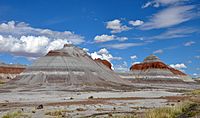 |
Arizona | December 9, 1962 | 221,390 | 505,209 | This park has a huge amount of 225-million-year-old petrified wood (wood that has turned into stone). The surrounding Painted Desert has colorful cliffs of red volcanic rock. Dinosaur fossils and over 350 Native American sites are also protected here. |
| Pinnacles | 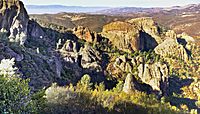 |
California | January 10, 2013 | 26,686 | 275,023 | Named for the eroded remains of an extinct volcano, this park's huge black and gold rock formations are popular for rock climbers. Hikers can explore trails through the wilderness. It's one of the few places where you can see the endangered California condor in the wild. |
| Redwood | 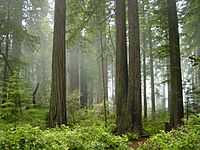 |
California | October 2, 1968 | 138,999 | 458,400 | This park and its co-managed state parks protect almost half of all remaining coastal redwoods, which are the tallest trees on Earth! The area is very active with earthquakes and has three large river systems. You can also explore 37 miles of protected coastline with tide pools. (This is a World Heritage Site.) |
| Rocky Mountain | 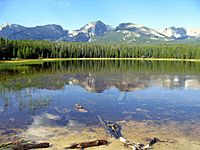 |
Colorado | January 26, 1915 | 265,848 | 4,300,424 | This part of the Rockies is divided by the Continental Divide. It has many ecosystems, from over 150 lakes to forests and treeless alpine tundra. You might see elk, moose, bighorn sheep, and black bears. (This is a Biosphere Reserve.) |
| Saguaro | 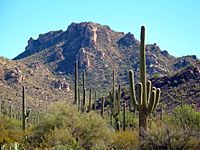 |
Arizona | October 14, 1994 | 92,877 | 908,194 | This park is split into two separate areas. It shows that the dry Sonoran Desert is home to a wide variety of life. Beyond the famous giant saguaro cacti, you'll find barrel cacti, chollas, and prickly pears, as well as bats and owls. |
| Sequoia | 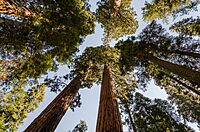 |
California | September 25, 1890 | 404,063 | 1,153,198 | This park protects the Giant Forest, which has some of the world's largest trees, including the General Sherman tree. Other features include over 240 caves, a long part of the Sierra Nevada mountains (including the tallest mountain in the contiguous U.S.), and Moro Rock, a huge granite dome. (This is a Biosphere Reserve.) |
| Shenandoah | 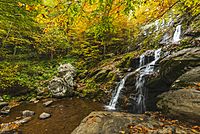 |
Virginia | December 26, 1935 | 200,446 | 1,449,300 | Shenandoah's Blue Ridge Mountains are covered by hardwood forests full of diverse wildlife. The Skyline Drive and Appalachian Trail run the entire length of this narrow park, along with over 500 miles of hiking trails. |
| Theodore Roosevelt | 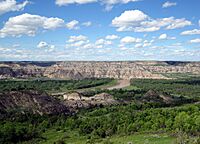 |
North Dakota | November 10, 1978 | 70,447 | 668,679 | This park, which inspired President Theodore Roosevelt, has three sections in the northern badlands. Besides Roosevelt's historic cabin, you can enjoy scenic drives and hiking. Wildlife includes American bison, pronghorn, and wild horses. |
| Virgin Islands | 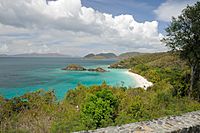 |
U.S. Virgin Islands | August 2, 1956 | 15,052 | 196,752 | This island park on Saint John protects beautiful beaches surrounded by mangrove forests, seagrass beds, and coral reefs. It also has ancient Taíno archaeological sites and the ruins of sugar plantations from Columbus's time. |
| Voyageurs | 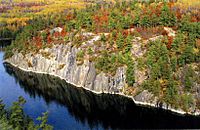 |
Minnesota | April 8, 1975 | 218,222 | 221,434 | This park protects four lakes near the Canada–US border. It's a great place for canoeing, kayaking, and fishing. The park also tells the story of the Ojibwe Native Americans, French fur traders (called voyageurs), and gold miners. |
| White Sands |  |
New Mexico | December 20, 2019 | 146,344 | 705,127 | Located in the Tularosa Basin, White Sands has the world's largest field of white sand dunes made of gypsum crystals. The park is inside the White Sands Missile Range and sometimes closes for tests. |
| Wind Cave | 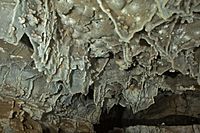 |
South Dakota | January 9, 1903 | 33,971 | 607,418 | Wind Cave is famous for its unique calcite formations called boxwork and needle-like growths called frostwork. It's one of the longest caves in the world and creates a "wind" as air pressure changes. Above ground, you can see bison, black-footed ferrets, and prairie dogs. |
| Wrangell–St. Elias | 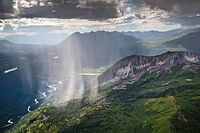 |
Alaska | December 2, 1980 | 8,323,146 | 65,236 | This is the largest national park in the U.S. It protects where several mountain ranges meet, including many of North America's tallest mountains and volcanoes. More than a quarter of the park is covered with glaciers, like the huge Hubbard Glacier. (This is a World Heritage Site.) |
| Yellowstone |  |
Wyoming, Montana, Idaho | March 1, 1872 | 2,219,791 | 3,290,242 | Located on the Yellowstone Caldera, this park has many geothermal areas like boiling mud pots, colorful hot springs (like Grand Prismatic Spring), and geysers that erupt regularly, such as Old Faithful. It's one of the best places to see wildlife, including wolves, grizzly bears, bison, and elk. (This is a World Heritage Site and a Biosphere Reserve.) |
| Yosemite | 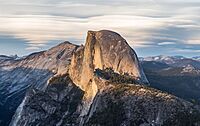 |
California | October 1, 1890 | 761,748 | 3,667,550 | Yosemite is famous for its sheer granite cliffs, incredibly tall waterfalls, and old-growth forests. Half Dome and El Capitan rise from the park's heart, the glacier-carved Yosemite Valley. Yosemite Falls is one of North America's tallest waterfalls. (This is a World Heritage Site.) |
| Zion | 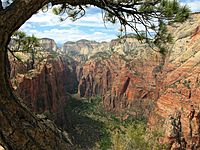 |
Utah | November 19, 1919 | 147,243 | 4,692,417 | This park is where the Colorado Plateau, Great Basin, and Mojave Desert meet. It has amazing sandstone features like mesas, rock towers, and canyons, including the Virgin River Narrows. The park is divided into four ecosystems: desert, riparian, woodland, and coniferous forest. |
National Parks by State or Territory
This table shows which states and territories have national parks. "Exclusive parks" means parks entirely within one state or territory. "Shared parks" means parks that are in more than one state.
Territories are written in italics.
| State | Total parks | Exclusive parks | Shared parks |
|---|---|---|---|
| California | 9 | 8 | 1 |
| Alaska | 8 | 8 | — |
| Utah | 5 | 5 | — |
| Colorado | 4 | 4 | — |
| Arizona | 3 | 3 | — |
| Florida | 3 | 3 | — |
| Washington | 3 | 3 | — |
| Hawaii | 2 | 2 | — |
| New Mexico | 2 | 2 | — |
| South Dakota | 2 | 2 | — |
| Texas | 2 | 2 | — |
| Montana | 2 | 1 | 1 |
| Nevada | 2 | 1 | 1 |
| Wyoming | 2 | 1 | 1 |
| American Samoa | 1 | 1 | — |
| Arkansas | 1 | 1 | — |
| Indiana | 1 | 1 | — |
| Kentucky | 1 | 1 | — |
| Maine | 1 | 1 | — |
| Michigan | 1 | 1 | — |
| Minnesota | 1 | 1 | — |
| Missouri | 1 | 1 | — |
| North Dakota | 1 | 1 | — |
| Ohio | 1 | 1 | — |
| Oregon | 1 | 1 | — |
| South Carolina | 1 | 1 | — |
| U.S. Virgin Islands | 1 | 1 | — |
| Virginia | 1 | 1 | — |
| West Virginia | 1 | 1 | — |
| Idaho | 1 | — | 1 |
| North Carolina | 1 | — | 1 |
| Tennessee | 1 | — | 1 |
See also
 In Spanish: Anexo:Parques nacionales de Estados Unidos para niños
In Spanish: Anexo:Parques nacionales de Estados Unidos para niños


